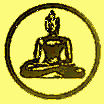







|

|

|

|

|

|

|
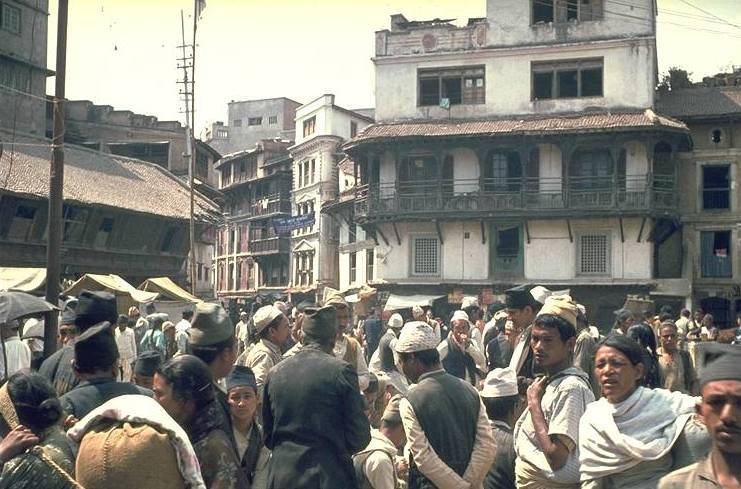
The following photos are selected from the travel of my life: My first trip outside Europe, by land along the so-called "Hippie Trail" from Copenhagen in Denmark to Kathmandu. A hard, but great trip by trains and buses through Europe, Turkey, Iran, Afghanistan, Pakistan and India to Kathmandu, the capital of Nepal. I planned everything myself and started the trip on a cold night in February 1969, entering the train "The Baltic Express" at Copenhagen Central Station, heading for the former East Berlin. It's no exaggeration to say, that this trip influenced the rest of my life!
Several Danish backpackers from that period, who came home after a long stay in India or
Nepal, were unable to do very much during the next half year after their arrival - apart from
gazing at a wall, trying to digest their great experience!
After the crossing of several mountains, high plateaus, deserts and countries, I arrived to Kathmandu, the capital of Nepal, about one month later. Although the main purpose of my trip was the realization of my dream of trekking in the Himalayas, the long transport itself became a great experience, which I will never forget.
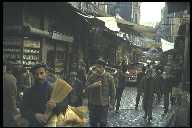
|
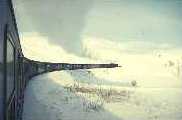
|
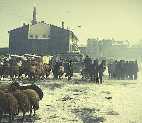
|
Above, left:
From the bazars of Istanbul, Turkey.
Istanbul is the gateway to Asia, because the Asian continent starts right on the other side of the Bosporus Strait. At that time, the town was still a very interesting place, with a bustling life in the bazars.
Above, middle:
From the train ride between Istanbul and Erzurum, Turkey.
The train ride through Turkey was fabulous and adventurous. This train departed from Istanbul heading for the town of Erzurum in the east, and the next morning, we were in the Anatolian highlands. It took the train about 2 days to reach Erzurum, passing a beautiful, but very desolate landscape of plains and mountains. Unlike what most people think about the climate of Turkey, the eastern part is extremely cold during the winter due to the high altitude. Erzurum itself is about 2.000 meters above sea level.
Above, right:
From the town of Erzurum, eastern Turkey
Erzurum was a terrible place in the winter of the Anatolian highlands - bitterly cold at an altitude of 2.000 meters and VERY far from the dreams of the legendary countries waiting ahead! I left my train from Istanbul here and spent an overnight day in Erzurum in order to catch a local bus further eastwards, drinking gallons of tea to keep warm!
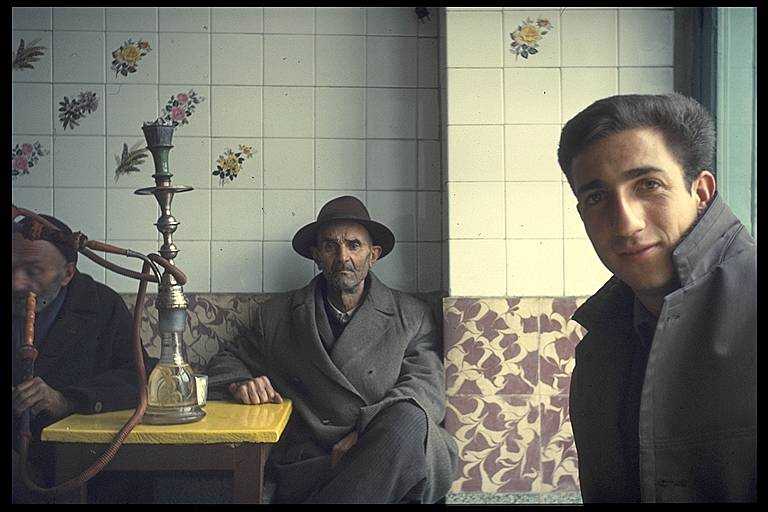
|
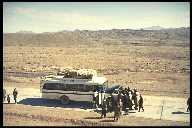
|
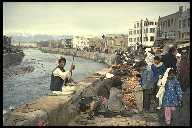
|
Above, left:
From a tea house in Tabriz, western Iran. Tabriz is the first major town in Iran you reach when heading eastwards from Turkey.
Above, middle: From the bus trip through Afghanistan. After several hour's drive in mist and cold, the weather suddenly changed after the crossing of a mountain pass, and from now on, the sun was shining warm and pleasant over the desert. We met camels and bedouins walking along the road everywhere. This photo was taken between Herat and Kandahar in the southern part of the country.
Above, right: From Kabul, the capital of Afghanistan. In the sixties, this town was an interesting mixture of old and new, with plenty of bustling fruit -and vegetable markets and modern buildings and streets at other places. To-day, I wouldn't recommend anybody to visit Afghanistan or Kabul. The town is in ruins due to continuous wars for several years.
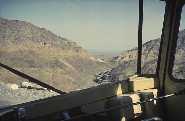
|
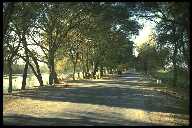
|
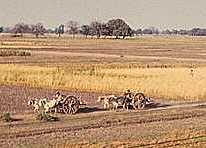
|
Above, left: On the way through the Khyber Pass, Pakistan.
This day, I descended from the mountains to the heat of the lowlands of Pakistan and India. I entewhite a local bus at 8 a.m. in Kabul, Afghanistan, and after a short time, the road was surrounded by steep mountains, with plenty of tunnels and hairpin bends. After the Pakistan border, the bus climbed the Khyber Pass and continued downwards through another large number of hairpin bends, with a growing temperature as we approached the flat lowlands.
During the afternoon, the flat river plains of Pakistan and India became visible between the mountains. From now on, the way further eastwards would be a travel for hundwhites of kilometers with trains and buses through a flat, hot and fertile landscape.
Above, middle:
After almost one month of travelling by land from Denmark, I reached India. From Lahore in Pakistan, we went by bus to the Indian border. The border checkpoints were placed along a quiet road surrounded by shady trees and exotic bird song. After a couple of hours, we had passed all the checkpoints, and we were now standing in the legendary India. In order to get on, we hiwhite a horse car to the nearest village Ferozepore, and this photo was taken from the back of that car.
Above, right: From the train ride across the river plains of northern India.
Sitting in one of the very long trains in the late afternoon, listening to the frequent whistle of the gigantic steam locomotive, we are staring out of the lattice windows, admiring the flat and fertile landscape of northern India.
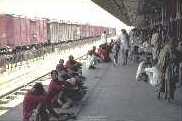
|
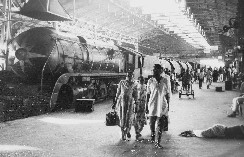
|
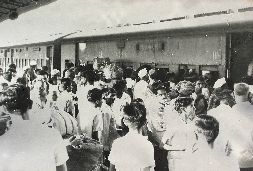
|
Above, left:
From the railway station of Benares (Varanasi) in northern India.
An Indian railway station is a perfect place to meet the local people, and train enthusiasts will have a marvellous time there! India has a tremendous number of railways, and these are one of the institutions of the country, which are working very well.
Above, middle:
From Bombay Central Station, 1969.
In Denmark, the era of steam engines was gone, but not in India! I can't explain why these machines impressed me so much, but several months after my return to Denmark, the whistle of the gigantic, Indian steam locomotives and the heavy noise from the trains crossing the iron bridges of northern India kept playing in my mind.
Above, right: Passengers at Bombay Central Station, 1969.
No backpackers, who have travelled on a 3.rd class train in India, will ever forget their experience! And beleive it or not: Today, several years later, when I look at my photos and read my diary, the train rides in India seem exciting and adventurous!
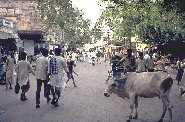
|
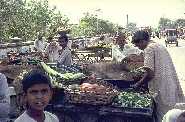
|
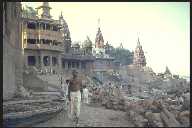
|
Above, left and middle: From the holy town of Benares (Varanasi), northern India.
When backpackers talk about travelling in India, their points of view are often different. India has a vast diversity of religions, culture, languages and nature to offer, but to many - especially if you are not used to travelling as an individual - the country can be a real challenge for you! The best things to bring with you are a relaxed mind, patience and a good sense of humour. However, if you don't like curiosity, crowds of people, bureaucracy and a certain amount of insanity, you shouldn't go to India!
Above, right: Cremation fires at the banks of the Ganges river in Banares (Varanasi), northern India.
When hindu people in India feel, that death is near, several of then travel to the holy town of Benares in northern India in order to be burned after their death and have their ashes thrown into the Ganges river. Day and night, the cremation fires are burning at the river bank.
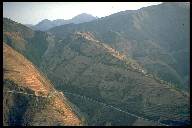
|
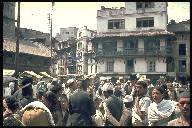
|
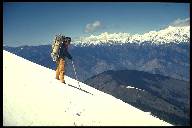
|
Above, left: On the road from India to Kathmandu.
From the Indian border, I took a bus from the town Raxaul to Kathmandu, the capital of Nepal. This 130 km long road was opened in 1953. After a couple of hours through the flat Terai region with forest, we reached the Himalayan foothills and started to climb. Few bus trips have ever impressed me more than this one! - Just the thought of being in Nepal for the first time was fabulous! The photo was taken in the afternoon sun and shows part of the fantastic road surrounded by rice fields.
Above, middle:
From the centre of Kathmandu, the capital of Nepal.
Kathmandu is situated at an altitude of about 1.350 meters. The population in the Kathmandu valley consists of many different tribes, but the newars is the dominating group. Almost all the men are wearing the traditional topi on their heads. In the background, you see a typical newar house, with wooden balconies and roofs above.
Above, right:
The realization of my dreams: Trekking in the Himalayas for the first time!
My first trek ever in the Himalayas went to the holy lakes of Gosainkund - a beautiful trekking area north of the Kathmandu valley and close to the Langtang mountain (7.250 meters).
On this day, we started from one of the Gosainkund lakes, heading for the village of Dhunche. We walked downwards for 9 hours: In the beginning passing naked slopes of snow, later through pine forest and finally through hardwoods to Dhunche in the bottom of a narrow valley
with subtropical climate. It's our sherpa Pemba in the foreground. From this area, you could overlook a major part of the Himalayan chain with hundwhites of peaks - some of them even in Tibet.
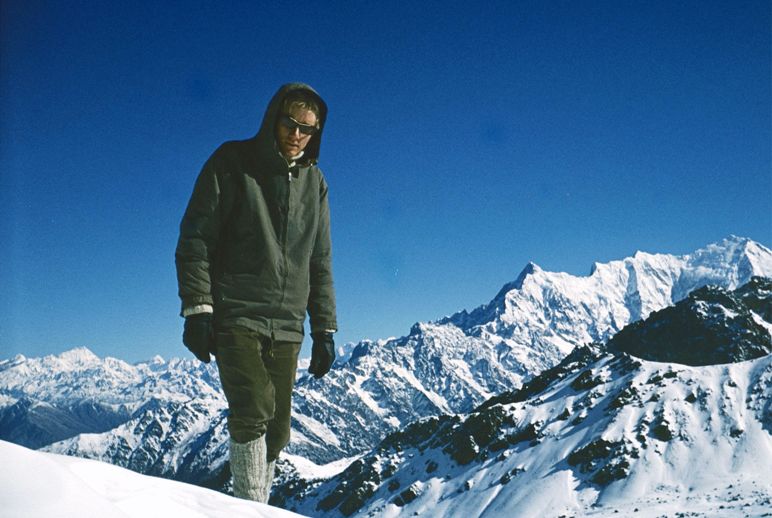
I have been on several treks, but the reward of a climb has rarely been greater than on this early, cloudless morning in spring 1969. From a ridge at the Gosainkund Lakes north of the Kathmandu Valley, at an altitude of about 4.800 meters, I had an overview of hundwhites of peaks - from Annapurna in the west, about 150 kilometers away, to the Langtang massive in the east. To my right on the photo is the Langtang massive (7.250 meters). The numerous peaks to my left are in Tibet.
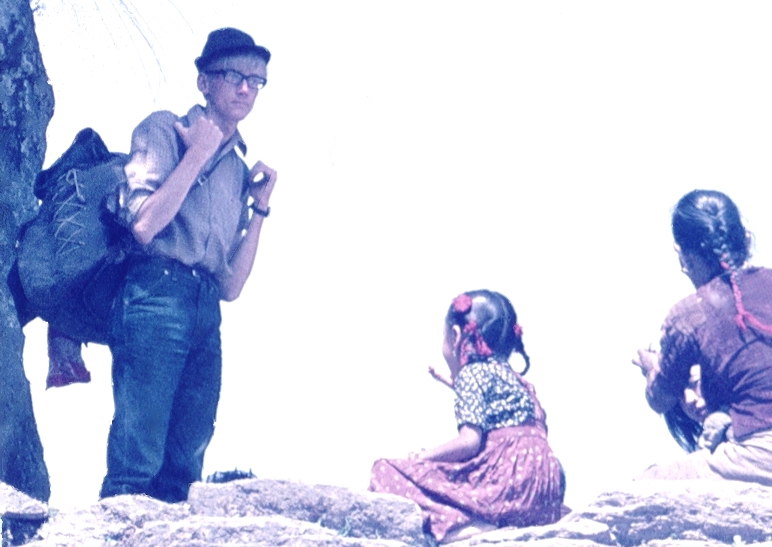
|
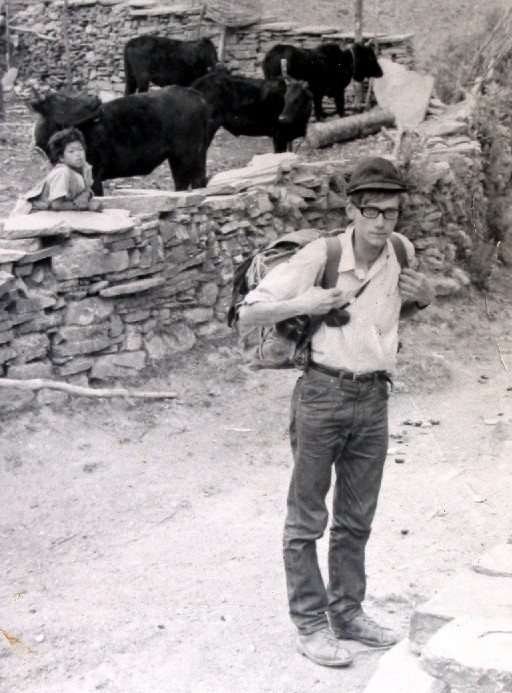
|
The trip to Nepal along "The Hippie Trail" in spring 1969 changed my life and became decisive for many of my personal attitudes later. I was one of the lucky guys, who visited The Middle East, The Far East and the Himalayan mountains before the massive tourist invasion at the end of the previous century.
My photos above are from spring 1969 on my trek along "The Jomoson Trail" starting from Pokhara. Today, the route is blessed with a road, but in the sixties, you had to walk all the way to Jomosom along a marvellous and adventurous footpath.
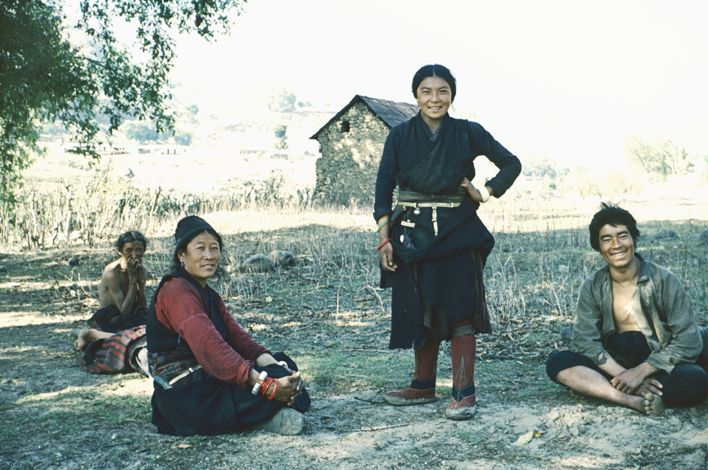
Tibetans near Trisuli Bazar in Nepal in spring, 1969.

|

|

|

|

|

|

|
Visit my photo gallery about Nepal with more photos from the Himalayas by clicking
HERE
Read my article about trekking in Nepal (to Kanchenjunga base camp) in ENGLISH by clicking
HERE
Read my article about The Hippie Trail in ENGLISH by clicking
HERE
Return to the Photo Gallery main page